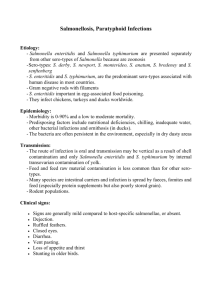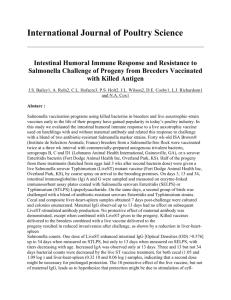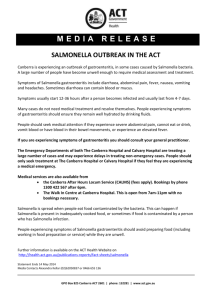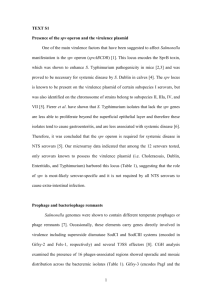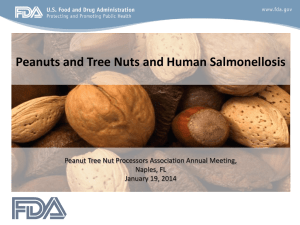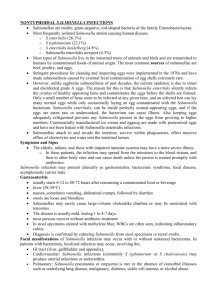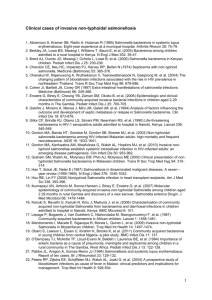BIOTECHNOLOGIC METHODS AND TESTS FOR IMPROVING THE
advertisement
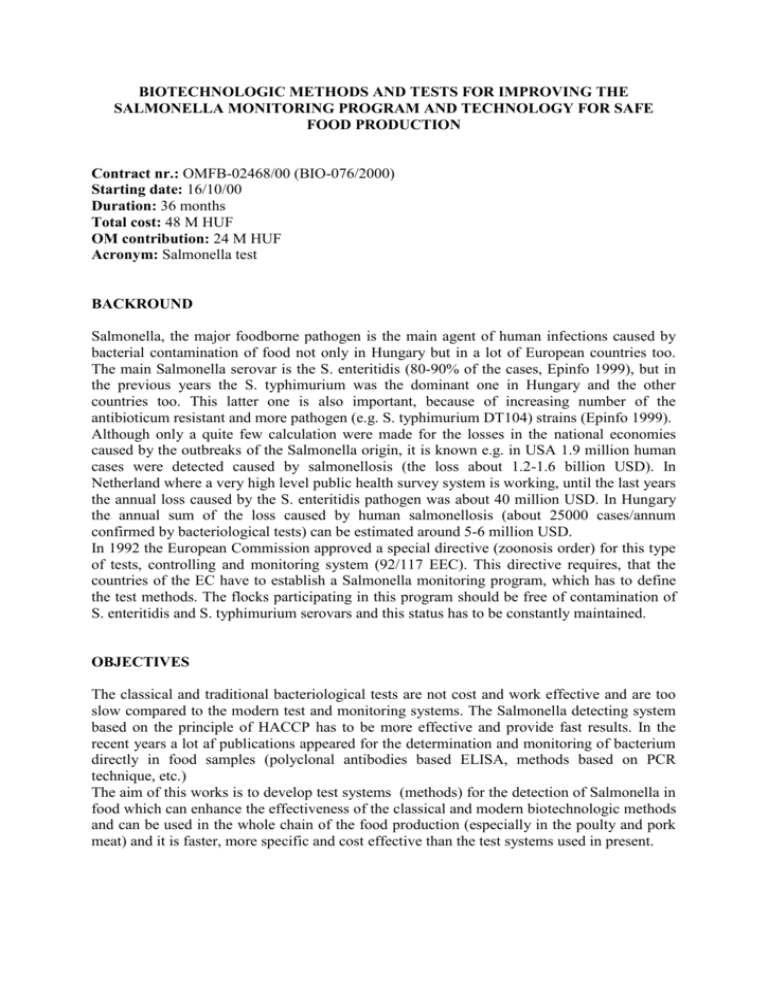
BIOTECHNOLOGIC METHODS AND TESTS FOR IMPROVING THE SALMONELLA MONITORING PROGRAM AND TECHNOLOGY FOR SAFE FOOD PRODUCTION Contract nr.: OMFB-02468/00 (BIO-076/2000) Starting date: 16/10/00 Duration: 36 months Total cost: 48 M HUF OM contribution: 24 M HUF Acronym: Salmonella test BACKROUND Salmonella, the major foodborne pathogen is the main agent of human infections caused by bacterial contamination of food not only in Hungary but in a lot of European countries too. The main Salmonella serovar is the S. enteritidis (80-90% of the cases, Epinfo 1999), but in the previous years the S. typhimurium was the dominant one in Hungary and the other countries too. This latter one is also important, because of increasing number of the antibioticum resistant and more pathogen (e.g. S. typhimurium DT104) strains (Epinfo 1999). Although only a quite few calculation were made for the losses in the national economies caused by the outbreaks of the Salmonella origin, it is known e.g. in USA 1.9 million human cases were detected caused by salmonellosis (the loss about 1.2-1.6 billion USD). In Netherland where a very high level public health survey system is working, until the last years the annual loss caused by the S. enteritidis pathogen was about 40 million USD. In Hungary the annual sum of the loss caused by human salmonellosis (about 25000 cases/annum confirmed by bacteriological tests) can be estimated around 5-6 million USD. In 1992 the European Commission approved a special directive (zoonosis order) for this type of tests, controlling and monitoring system (92/117 EEC). This directive requires, that the countries of the EC have to establish a Salmonella monitoring program, which has to define the test methods. The flocks participating in this program should be free of contamination of S. enteritidis and S. typhimurium serovars and this status has to be constantly maintained. OBJECTIVES The classical and traditional bacteriological tests are not cost and work effective and are too slow compared to the modern test and monitoring systems. The Salmonella detecting system based on the principle of HACCP has to be more effective and provide fast results. In the recent years a lot af publications appeared for the determination and monitoring of bacterium directly in food samples (polyclonal antibodies based ELISA, methods based on PCR technique, etc.) The aim of this works is to develop test systems (methods) for the detection of Salmonella in food which can enhance the effectiveness of the classical and modern biotechnologic methods and can be used in the whole chain of the food production (especially in the poulty and pork meat) and it is faster, more specific and cost effective than the test systems used in present. DESCRIPTION 1., Selective pre-enrichment : development of an immunosorbent technique based on Salmonella specific monoclonal antibodies. a., isolation, purification of various Salmonella antigen preparations, immunization for production of specific and high affinity monoclonal antibodies. b., test of the monoclonal antibodies for specificity and affinity. c., production (in vitro) of the selected monoclonal antibodies with high affinity. d., binding (coating) of selected monoclonal antibody preparations on solid phase (magnetic particles, wall of polystirol microtubes etc.) 2., Development of test methods for the detection of presence or absence of various Salmonella serovars (S. enteritidis, S. typhimurium). a.,development of different detection systems based on monoclonal antibodies Photometric measurement and/or Luminometric measurement and detection of their specificity and sensitivity. b., selection, production and application of reagents for gentechnologic method (PCR) for Salmonella test: selection and application of previously known primers for our system synthetization of other primers (S. enteritidis, S typhimurium, Salmonella (common), etc.) and application for our system. CURRENT RESULT In the current period we have already done the following steps in works of development: a., The isolation and preparation of the antigen preparation of S. enteritidis and S. typhimurium serovars. Immunisation of BALB/c mice with these antigen preparations and the cell fusions for the production of antibody producing hybridoma cell lines. Test and selection of cell lines producing the proper antibody. b., Test the supernatants of antibody producing hybridomas for specificity and affinity. c., Antibody production by in vitro technique and purification of the immunglobulin fraction containing the proper antibody. d., Binding of the antibody preparates on solid phase to test the optimal circumstances of the binding reaction for the Salmonella enrichment in the test preparation (in progress). COORDINATOR Ferenc Péterfy Diagnosticum Ltd. Attila u. 126. H- 1047 Budapest Tel: 36-369 0739, 369 3684 Fax: 369 4383 E-mail: peterfy@diagnosticum.hu PARTNER Béla Nagy MTA ( Hungarian Academy of Science) Veterinary Research Institute Hungária Krt. 21. H-1143 Budapest Tel:252-2455 Fax:252-1069 E-mail: bnagy@novell.vmri.hu

